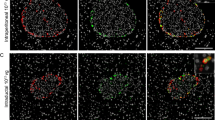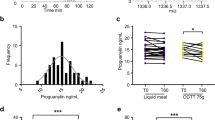Abstract
We report the histological, immunohistochemical and ultrastructural changes in mice containing a chimeric glucagon-simian virus 40 T antigen (SV40Tag) gene. Transgene expression was detected in endocrine cells of pancreas, small and large intestine. Hyperplasia of glucagon-containing cells developed in pancreas and large bowel by gestational day 19. In large bowel, hyperplastic cells increased in number postnatally and invasive carcinomas were identified at 4 weeks; several animals had lymph node metastases. In contrast, no pathology was detected in the small bowel in any of the transgenic mice. Colonic tumours expressed SV40Tag, proglucagon-derived peptides and peptide YY (PYY); scattered cells contained cholecystokinin or glycoprotein hormone α-subunit. Somatostatin or serotonin was also detected in some tumours. By electron microscopy, the colonic tumours retained features of endocrine differentiation, but secretory granules were smaller than those of non-tumorous intestinal glucagon-producing L cells. In postnatal pancreas, atypical cells containing SV40Tag and glucagon were initially clustered at the periphery of islets; this atypical hyperplasia progressed to neoplasia by 11–12 weeks. Some neoplastic pancreatic cells contained glucagon, PYY or vasoactive intestinal peptide immunopositivity, but most were negative for all peptides; they contained immunoreactivity for tyrosine hydroxylase and by electron microscopy, pancreatic tumour cells had neuronal features. Pancreatic polypeptide was not detected in the non-tumorous islets of transgenic animals. This line of transgenic mice provides a model for the analysis of endocrine tumour progression in the gut and pancreas.
Similar content being viewed by others
References
Ali-Rachedi A, Varndell IM, Adrian TE, Gapp DA, Noorden S van, Bloom SR, Polak JM (1984) Peptide YY (PYY) immunoreactivity is co-stored with glucagon-related immunoreactants in endocrine cells of the gut and pancreas. Histochemistry 80:487–491
Alpert S, Hanahan D, Teitelman G (1988) Hybrid insulin genes reveal a developmental lineage for pancreatic endocrine cells and imply a relationship with neurons. Cell 53:295–308
Astrin SM, Costanzi C (1989) The molecular genetics of colon cancer. Semin Diagn Pathol 16:138–147
Axelson J, Ekelund M, Sundler F, H»kanson R (1990) Enhanced hyperplasia of gastric enterochromaffinlike cells in response to omeprazole-evoked hypergastrinemia in rats with portacaval shunts. An immunocytochemical and chemical study. Gastroenterology 99:635–640
Bell RH Jr, Memoli VA, Longnecker DS (1990) Hyperplasia and tumors of the islets of Langerhans in mice bearing an elastase 1-SV40 T-antigen fusion gene. Carcinogenesis 11:1393–1398
Bosman FT (1989) Endocrine cells in non-endocrine tumours. J Pathol 159:181–182
Böttcher G, Sjölund K, Ekblad E, H»kanson R, Schwartz TW, Sundler F (1984) Coexistence of peptide YY and glicentin immunoreactivity in endocrine cells of the gut. Regul Pept 8:261–266
Böttcher G, Alumets J, J»kanson R, Sundler F (1986) Co-existence of glicentin and peptide YY in colorectal L-cells in cat and man. An electron microscopic study. Regul Pept 13:283–291
Brubaker PL, Drucker DJ, Asa SL, Greenberg GR (1991) Regulation of peptide-YY synthesis and secretion in fetal rat intestinal cultures. Endocrinology 129:3351–3358
Brubaker PL, Lee YC, Drucker DJ (1992) Alterations in proglucagon processing and inhibition of proglucagon gene expression in transgenic mice which contain a chimeric proglucagon-SV40 T antigen gene. J Biol Chem 267:20728–20733
Campos RV, Drucker DJ (1992) Transgenic mice in the study of endocrine systems. Endocr Pathol 3:111–115
Cheng H, Leblond CP (1974) Origin, differentation and renewal of the four main epithelial cell types in the mouse small intestine. V. Unitarian theory of the origin of the four epithelial cell types. Am J Anat 141:537–562
Cheng H, Leblond CP (1974) Origin, differentiation and renewal of the four main epithelial cell types in the mouse small intestine. III. Entero-endocrine cells. Am J Anat 141:503–520
Colony PC, Helmstaedter V, Moody AJ, Garaud JC, Forssmann WG (1982) Glucagon and glicentin immunoreactive cells in human colon. Cell Tissue Res 221:483–491
Drucker DJ, Asa SL (1988) Glucagon gene expression in vertebrate brain. J Biol Chem 263:13475–13478
Efrat S, Linde S, Kofod H, Spector D, Delannoy M, Grant S, Hanahan D, Baekkeskov S (1988) Beta-cell lines derived from transgenic mice expressing a hybrid insulin gene-oncogene. Proc Natl Acad Sci USA 85:9037–9041
Efrat S, Teitelman G, Anwar M, Ruggiero D, Hanahan D (1988) Glucagon gene regulatory region directs oncoprotein expression to neurons and pancreatic α cells. Neuron 1:605–613
Fiocca R, Capella C, Buffa R, Fontana R, Solcia E, Hage E, Chance RE, Moody AJ (1980) Glucagon-, glicentin-, and pancreatic polypeptide-like immunoreactivities in rectal carcinoids and related colorectal cells. Am J Pathol 100:81–92
Fiocca R, Rindi G, Capella C, Grimelius L, Polak JM, Schwartz TW, Yanaihara N, Solcia E (1987) Glucagon, glicentin, proglucagon, PYY, PP and proPP-icosapeptide immunoreactivities of rectal carcinoid tumors and related non-tumor cells. Regul Pept 17:9–29
Fujita T (1976) The gastro-enteric endocrine cell and its paraneuronic nature. In: Coupland RE, Fujita T (eds) Chromaffin, enterochromaffin and related cells. Elsevier, Amsterdam, pp 191–208
Garaud JC, Eloy R, Moody AJ, Stock C, Grenier JF (1980) Glucagon- and glicentin-immunoreactive cells in the human digestive tract. Cell Tissue Res 213:121–136
Grant SGN, Seidman I, Hanahan D, Bautch VL (1991) Early invasiveness characterizes metastatic carcinoid tumors in transgenic mice. Cancer Res 51:4917–4923
Hanahan D (1985) Heritable formation of pancreatic β-ell tumours in transgenic mice expressing recombinant insulin/simian virus 40 oncogenes. Nature 315:115–122
Hanahan D (1989) Transgenic mice as probes into complex systems. Science 246:1265–1275
Herrera P-L, Huarte J, Sanvito F, Meda P, Orci L, Vassalli J-D (1991) Embryogenesis of the murine endocrine pancreas; early expression of pancreatic polypeptide gene. Development 113:1257–1265
Hogan B, Constantini F, Lacy E (1986) Manipulating the mouse embryo: a laboratory manual. Cold Spring Harbor Laboratory, Cold Spring Harbor, NY
Jaenisch R (1988) Transgenic animals. Science 240:1468–1474
Kirkland SC (1988) Clonal origin of columnar, mucous, and endocrine cell lineages in human colorectal epithlium. Cancer 61:1359–1363
Larsson L-I (1977) Ontogeny of peptide-producing nerves and endocrine cells of the gastro-duodeno-pancreatic region. Histochemistry 54:133–142
Lee YC, Asa SL, Drucker DJ (1992) Glucagon gene 5'-flanking sequences direct expression of simian virus 40 large T antigen to the intestine, producing carcinoma of the large bowel in transgenic mice. J Biol Chem 267:10705–10708
Lewin KJ (1986) The endocrine cells of the gastrointestinal tract. The normal endocrine cells and their hyperplasias. Pathol Annu 21:1–27
Munger BL (1981) Morphological characterization of islet cell diversity. In: Cooperstein SJ, Watkins D (eds) The islets of Langerhans. Academic Press, New York, pp 3–34
Murphy D, Bishop A, Rindi G, Murphy MN, Stamp GWH, Hanson J, Polak JM, Hogan B (1987) Mice transgenic for a vasopressin-V40 hybrid oncogene develop tumors of the endocrine pancreas and the anterior pituitary: a possible model for human multiple endocrine neoplasia type 1. Am J Pathol 129:552–566
Nigro JM, Baker SJ, Preisinger AC, Jessup JM, Hostetter R, Cleary K, Bigner SH, Davidson N, Baylin S, Devilee P, Glover T, Collins FS, Weston A, Modali R, Harris CC, Vogelstein B (1989) Mutations in the p53 gene occur in diverse human tumour types. Nature 342:705–708
Nilsson O, Bilchik AJ, Goldenring JR, Ballantyne GH, Adrian TE, Modlin IM (1991) Distribution and immunocytochemical colocalization of peptide YY and enteroglucagon in endocrine cells of the rabbit colon. Endocrinology 129:139–148
Pearse AGE (1974) The APUD cell concept and its implications in pathology. Pathol Annu 9:27–41
Pearse AGE (1984) Islet development and the APUD concept. In: Klöppel G, Heitz PU (eds) Pancreatic pathology. Churchill Livingstone, Edinburgh, pp 125–132
Pictet RL, Rall LB, Phelps P, Rutter WJ (1976) The neural crest and the origin of the insulin-producing and other gastrointestinal hormone-producing cells. Science 191:191–192
Powers AC, Philippe J, Hermann H, Habener JF (1988) Sodium butyrate increases glucagon and insulin gene expression by recruiting immunocytochemically negative cells to produce hormone. Diabetes 37:1405–1410
Rindi G, Grant SGN, Yiangou Y, Ghatei MA, Bloom SR, Bautch VL, Solcia E, Polak JM (1990) Development of neuroendocrine tumors in the gastrointestinal tract of transgenic mice. Heterogeneity of hormone expression. Am J Pathol 136:1349–1363
Rindi G, Efrat S, Ghatei MA, Bloom SR, Solcia E, Polak JM (1991) Glucagonomas of transgenic mice express a wide range of general neuroendocrine markers and bioactive peptides. Virchows Arch [A] 419:115–129
Rindi G, Solcia E, Polak JM (1991) Peptide expression patterns in neuroendocrine tumors of transgenic mice. In: Fuxe K, Agnati LF (eds) Volume transmission in the brain: novel mechanisms for neural transmission. Raven Press, New York, pp 227–235
Rombout JHWM, Grinten CPM van der, Peeze Binkhorst FM, Taverne-Thiele JJ, Schooneveld H (1986) Immunocytochemical identification and localization of peptide hormones in the gastro-entero-pancreatic (GEP) endocrine system of the mouse and a stomachless fish, Barbus conchonius. Histochemistry 84:471–483
Roth KA, Gordon JI (1990) Spatial differentiation of the intestinal epithelium: analysis of enteroendocrine cells containing immunoreactive serotonin, secretin, and substance P in normal and transgenic mice. Proc Natl Acad Sci USA 87:6408–6412
Schweisthal MR, Frost CC, Brinn JE (1976) Ontogeny of four cell types in fetal rat islets using histochemical techniques. Acta Diabetol Lat 13:30–39
Teitelman G, Joh TH, Reis DJ (1981) Transformation of catecholaminergic precursors into glucagon (A) cells in mouse embryonic pancreas. Proc Natl Acad Sci USA 78:5225–5229
Teitelman G, Alpert S, Polak JM, Martinez A, Hanahan D (1993) Precursor cells of mouse endocrine pancreas coexpress insulin, glucagon and the neuronal proteins tyrosine hydroxylase and neuropeptide Y, but not pancreatic polypeptide. Development 118:1031–1039
Upchurch BH, Aponte GW, Leiter AB (1994) Expression of peptide YY in all four islet cell types in the developing mouse pancreas suggests a common peptide YY-producing progenitor. Development 120:245–252
Weinberg RA (1991) Tumor suppressor genes. Science 254:1138–1146
Wright NA (1990) Endocrine cells in non-endocrine tumours. J Pathol 161:85–87
Author information
Authors and Affiliations
Rights and permissions
About this article
Cite this article
Asa, S.L., Lee, Y.C. & Drucker, D.J. Development of colonic and pancreatic endocrine tumours in mice expressing a glucagon-SV40 T antigen transgene. Vichows Archiv A Pathol Anat 427, 595–606 (1996). https://doi.org/10.1007/BF00202891
Received:
Accepted:
Issue Date:
DOI: https://doi.org/10.1007/BF00202891




